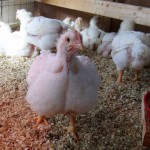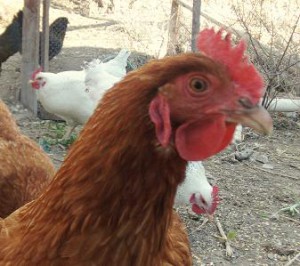by Esmaa Self
From the archives
Consider the parsnip. Sweet. Nutty. recipe. From fritters (recipe) to soup (recipe), homemade gnocchi (recipe) to curry (recipe), the mighty parsnip delivers folate, vitamin C, fiber and flavor. Even if you’ve never before tasted parsnips, my bet is that if you try one of these recipes, you’ll not only want more parsnips, you’ll want to grow your own (tips on that below).
Speaking of yum, here’s a recipe from Simple Organic Kitchen & Garden that I’ve adapted to fit the items in my pantry, notably dried tomatoes and porcini mushrooms. The original recipe is known as Parsnips and Chickpeas in Garlic, Onion, Chili and Ginger Paste. I added ingredients, skipped a couple others and decided to shorten the title to the equally descriptive Parsnips Piquant.
RECIPE
PARSNIPS PIQUANT
Ingredients
Click here for Imperial-metric recipe conversion
½ pound dried chickpeas, soaked overnight and drained (or 2 cans)
1 ½ cups dehydrated tomatoes, reconstituted and chopped
1 ½ cups dehydrated porcini mushrooms, reconstituted and chopped
2 ¼ cups vegetable broth (made from reconstituting mushrooms and tomatoes, see below)
½ cup chopped mixed salted nuts (set aside)
8 garlic cloves, minced
1 small onion, chopped
2 inch piece of fresh ginger, peeled and chopped
4 medium Serrano chilies, chopped
4 Tbsp porcini and sun-dried tomato infused olive oil (or plain olive, sesame, or peanut oil)
1 Tbsp sesame seeds
2 tsp coriander seeds
1 tsp turmeric
1 tsp chili powder
1 tsp ground cumin
Fresh ground pepper
Plain yogurt
Instructions
- Presoak chickpeas.
- Cover chickpeas with fresh water and boil for 10 minutes. Reduce heat, letting it boil gently. Let cook for 60 to 90 minutes, or until done. Drain and set aside. (If using canned chickpeas, simply drain and set aside.)
- Set tomatoes and mushrooms in a bowl; cover with boiling water. Let cool. Reserve broth.
- Set about a quarter of the minced garlic aside. Put remaining garlic in a blender with the ginger, onion and half of the chilies. Add enough vegetable broth to make a paste (about ¼ cup).
- Heat the oil in a frying pan; add coriander seeds, turmeric and chili powder. Add garlic-ginger-onion-chili paste. Stirring constantly, cook until broth begins to evaporate. Add tomatoes; stir. Cook another minute or two.
- Add the parsnips, chickpeas and remaining water; boil, stir then simmer, uncovered 15 minutes or until the parsnips are tender but not mushy and sauce has been reduced.
- Stir in Serranos, sesame seeds and reserved garlic.
- Plate Parsnips Piquant, add fresh ground pepper. Sprinkle with chopped nuts and a dollop of yogurt. Garnish with parsley. Serves 4.
- Chapatis, naan and kulcha make a lovely accompaniment, as does homemade sourdough or wheat berry bread.
Growing Parsnips
The parsnip’s full flavor emerges after the plant has been exposed to near freezing temperatures, thus this root crop is considered a winter vegetable. Here in Colorado where we redefine cool, if not winter, a person may scoff at the very idea of growing a slow maturing vegetable. But parsnips are the only root crop that can survive in the ground all winter. Indeed, it is one of the few crops with which high elevation gardeners might achieve success. (source)
According to Shane Smith, in his book, Greenhouse Gardener’s Companion, parsnips require bright light, cool temperatures and may go to seed if overwintered. So you might wonder if I’ve slipped a cog when I mention that I grew two small patches of parsnips last winter in our attached passive solar greenhouse and that both test plots were partly shaded and further that one of the beds regularly reached air temperatures above 87 F.
However, if I mentioned that I fully intend to seed parsnips again for Colorado’s less industrious, though longer, growing season (AKA winter), you might want details regarding these attempts. You are in luck.
Two tries, two successes
I planted one batch in early August for inclusion in December’s root crop rich menus. This first sowing was in the raised bed nearest the southern greenhouse vent, which is the bed furthest from the main house’s southern wall and which is largely shaded in winter, thus the coldest spot in the greenhouse. The soil does not freeze, though air temps do occasionally reach the mid 30s. The parsnips we harvested from this test plot were every bit as large and straight and lovely (not to mention sweet) as those we’ve purchased in the store.
In addition, I grew a dozen parsnips in the west wing. This second test plot is within three feet of the main house’s west wall. The bed receives afternoon sun, which in the winter months, means that air temperatures reach the nineties, but soil temperature remains between 50-65 F. In addition, overnight air temps are generally a few degrees warmer than those in the first plot. We planted the second crop of parsnips in mid-October and harvested them in late January. They were two-thirds the size of the others, but possessed incredible flavor. Parsnips from this plot are featured in the images of Parsnips Piquant, above.
Companion plants include peas, potatoes, peppers, beans, radishes and garlic. Get more parsnip growing tips here.
Read more about Esmaa’s organic farming techniques on her site Middleground Farm.
Related articles
|
|











































